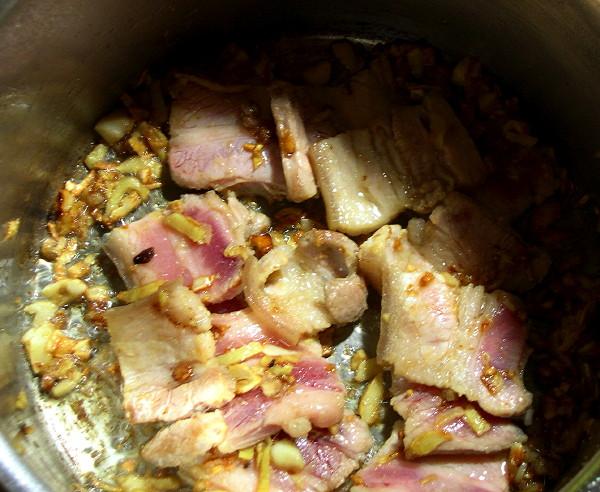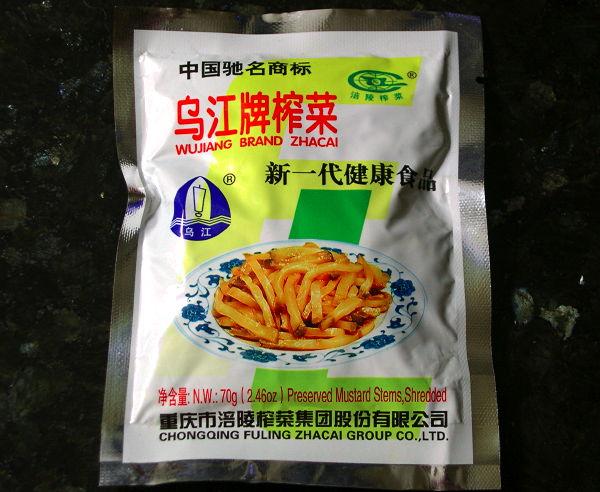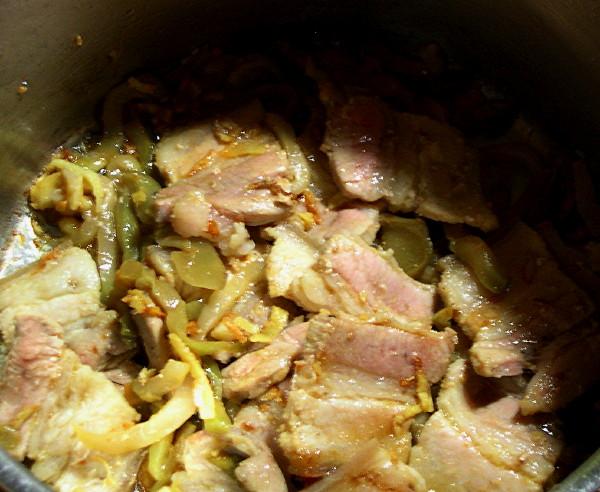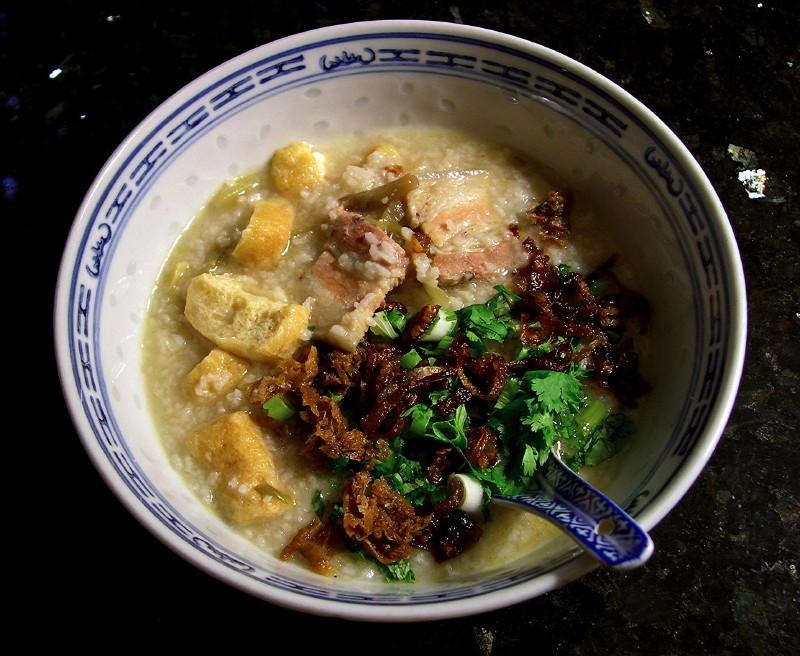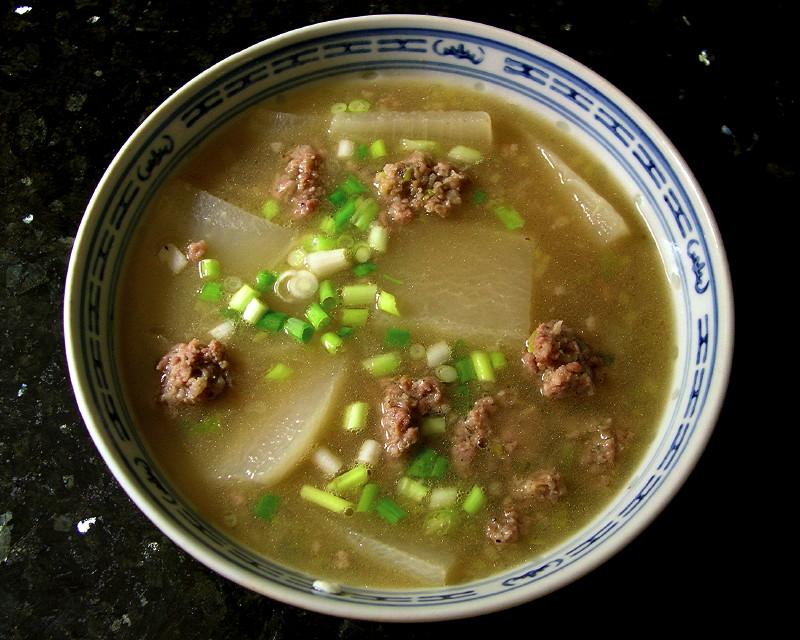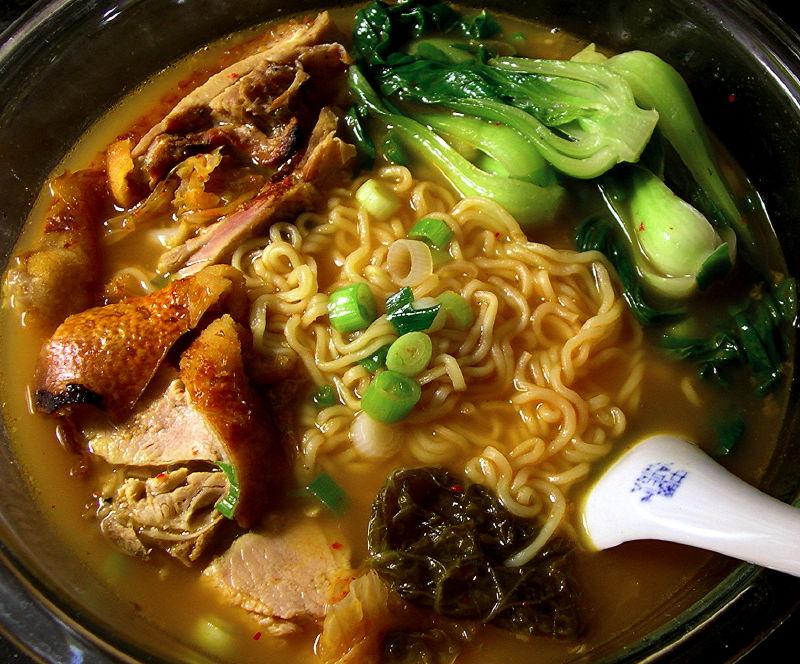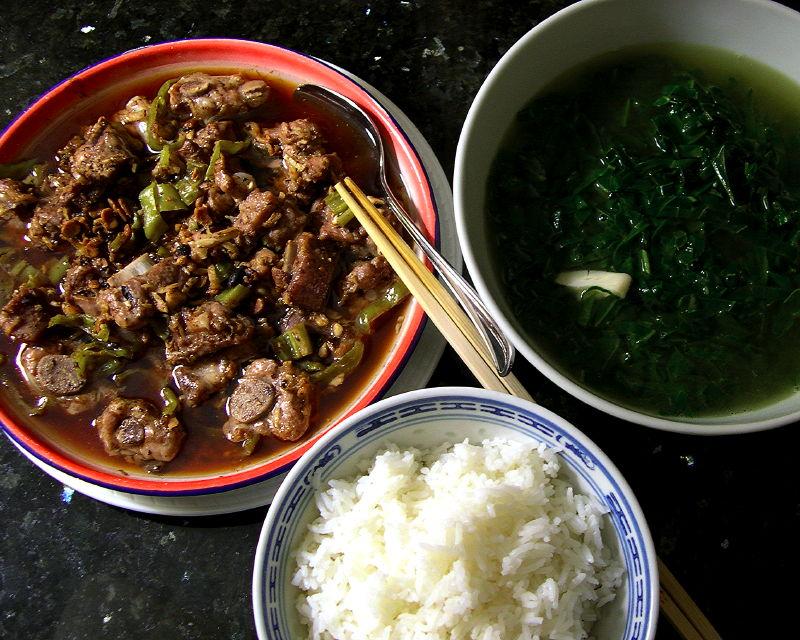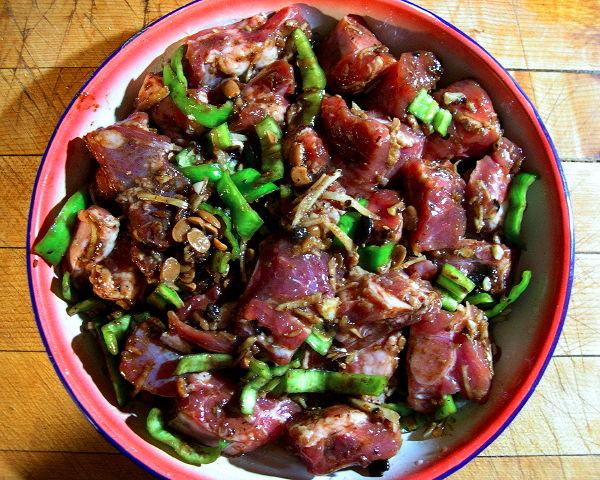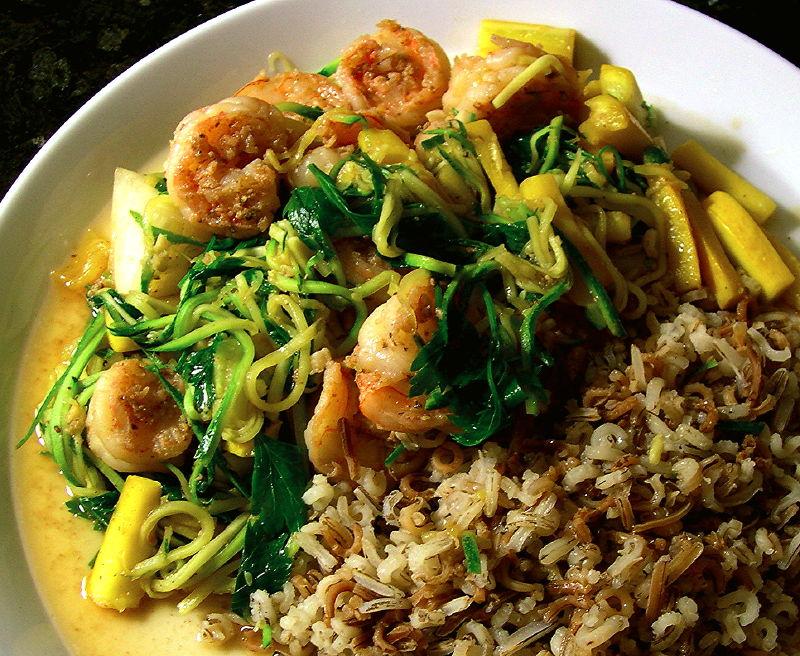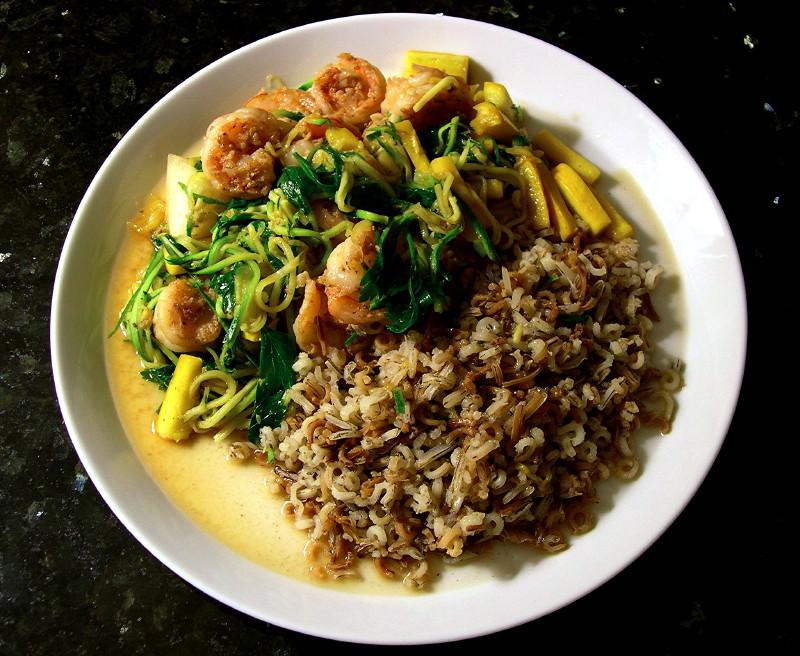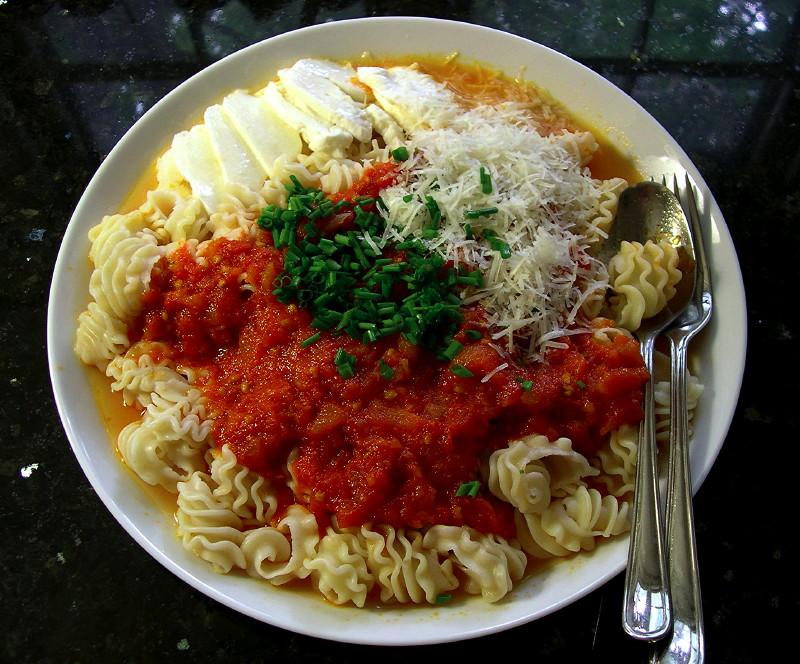-
Posts
3,810 -
Joined
-
Last visited
Content Type
Profiles
Forums
Store
Help Articles
Everything posted by huiray
-
Pork belly rice congee 2014-0824 Pork belly strip, skin-on, cut into slices about ¼ inch thick. Sautéed w/ ginger & garlic, chicken fat (rendered in the pot). Salted. Preserved mustard stems (see below) (榨菜; Cantonese ja3 choi3), rinsed, were added. The brand of mustard stems used today. Stuff in the pot. Water followed, and the mixture was simmered (covered) for about ¾ hour. Long grain rice went in, everything given a good stir, and simmering resumed for another ¾ hour or thereabouts. Water was added to adjust the consistency of the congee. Quartered soy puffs (these) went in about halfway through. A bowl of the finished congee, topped w/ chopped scallions & coriander leaves, deep-fried sliced shallots, and Tianjin preserved vegetable (these).
-
I tried the Thai-produced Maekrua oyster sauce side-by-side with the USA-produced Lee Kum Kee oyster sauce. I still prefer the LKK sauce, by far. The Maekrua sauce seemed more salty and sweet than oysterish. Definitely sweeter. JMTC.
-
Ah, OK. How about soups? Not the blended-to-smoothness Western types, but the E/SE Asian types with chunks of stuff including chicken pieces in a broth... BTW, the black vinegar is not *needed* or can be substituted with another vinegar in Kung Pao chicken without changing its basic nature, IMO... Or use balsamic vinegar plus red wine vinegar plus some sugar... The original dish would have peanuts or cashew nuts in it, anyway, and I assume your version does not have these because of your nut allergy. :-) ETA2: Regarding the "Lemon Chicken" suggested by Lisa Shock - simply leave out the lemon. That recipe sounds fine to me without the lemon. If really desired rice or white vinegar could be added instead. In fact, I myself would also cut down on the amount of sugar used in that recipe. In other words, use that recipe as a "jumping off point". The principle there is to steam chicken slices with a savory sauce that includes ginger and scallions, and the rest is up to you. I myself might incorporate mushrooms (especially shiitake-type), leaving out the lemons; or soy beans of some sort; or bean curd, chopped up or crumbled or, if you have it, "fu yee" or fermented bean curd steeped in rice wine etc. And so on.
-
How about some simple stir-fries? (You don't need a wok) Slice up the chicken breast(s), against the grain of course. Something simple then might be: hot oil in frying pan, chopped smashed garlic, fresh ginger sliced or julienned or chopped, chicken pieces, salt, vegetable of your choice suitable for a stir-fry (try celery, green or red bell-type peppers or poblano type etc,** mushrooms - even the standard button mushrooms work, semi-leafy vegetables with slightly harder stems (think kai lan), or even onions chopped into large pieces) cooking the veggies till they are still crunchy (that includes the mushrooms and onions) (If your family does not like crunchy vegetables in a cooked dish then leave out the vegetables altogether) Add some cut-up hot chillies in if you like. A splash of soy sauce if desired. Or try fistfuls of trimmed, washed basil (yes, basil) in large-ish pieces (tender stems included if they are tender) tossed in right before the end...Thai basil would be best for this but the standard Italian/Western type works fine too. Some cooking wine or cooking sake could also be added (except with the basil - I'd leave it out in that case; ditto soy sauce, that would clash w/ the Italian basil IMO) and the chicken slices could be pre-marinated before it hits the frying pan. Try chicken stir-fried w/ cucumbers and a fresh chilli – Hakka style. Here's a recipe by the author of "The Hakka Cookbook" using specifically skinless boneless chicken breasts. (One needs to "join" the site to see the video but the recipe and instructions are visible (click on the button for the details - look on the webpage) without "joining") How about "poaching" or steeping the chicken breast(s) in gingered hot water? This is similar to how Hainanese chicken or "white cut chicken" is done, except that just the breasts instead of the whole chicken is "steeped/poached". Smash some ginger, add to a pot of water (enough to cover the breasts plus maybe an inch more), bring to a boil, add the breasts in, return to a simmer/boil and shut off the heat; let the chicken sit in the hot water (salted if desired) till "just" cooked (say, around 15-20 minutes) (cut to test or use a meat thermometer), retrieve from the pot, plunge into cold water, retrieve, slice up (against the grain) and eat with something like ginger-scallion sauce with or without added chopped garlic as well, or with a chilli sauce in the SE Asian style. These are just a few simple suggestions; the variations and other dishes are many, including ones that are more involved. Do you have access to tamarind, galangal, lemongrass, E/SE Asian-style bean paste(s) or SE Asian-style shrimp paste(s)? If so the possibilities expand, especially with curries. ** ETA: Especially with peppers, I would tend to toss in fermented black beans into the stir-fry - but you may not have this.
-
I don't consciously remember you posting meals with a Chinese or E/SE Asian character here (yes, you cook South Asian dishes) so before I offer suggestions - do you cook or are interested in Chinese (South Chinese especially)/South-East Asian/Nyonya dishes?
-
Saturday 2014-0823. BRFM: Curly kale, mini cauliflower heads, Suyo long cucumber, angled loofah. CFM: Green & purple Chinese long beans, Japanese Trifele tomatoes, green zucchini, hot long red chillies, “Epi wheat stalk” bread loaf. Goose the Market: Tarentaise cheese, Cumberland cheese, monkfish.
-
FeChef, thanks for the info. Yes, that looks like dyed char-siu. The one in the pic looks decent, although not the kind I myself would go for when I seek char-siu but is a type commonly used by many places. (Traditionally, super-lean pork was not favored by many Chinese folks who preferred some fat in their meat - especially intercalated fat - which is why pork belly was amongst the most preferred cuts and amongst the most expensive, whereas lean cuts were often cheaper and a little harder to sell) The kind of char-siu (叉燒) you show can also have a sweetish glaze (in my experience) - it just depends on who made it and/or where one got it and so on; but yes, they would in general have a more "stripped down" taste profile with less "sweet notes" and less unctuousness than stuff like this, or this, which is what I would go for when looking for char-siu. :-) As an aside, a comment about the English terms used for this sort of stuff: I commonly see Chinese "BBQ pork" being used to describe char-siu, at least in the US, while Chinese "roast pork" tends to refer to siu-yook/siu-yuk (燒肉) which in this context is pork roasted with skin on (usually done commercially with the whole hog) and is definitely savory as compared with char-siu. Hence the uncertainty about which kind you were referring to in your OP.
-
Daikon & minced pork ball soup in pork bone soup. Chopped scallions. Somewhat milky pork stock¶ was made by gently boiling pork knuckle bones & etc in water (replenished as needed) with some sea salt for a total of somewhere around 8-10 hours (I lost track). Some sliced ginger went in halfway through. The bones had some residual meat and were given the fei sui treatment before starting the stock proper. A portion of the stock (most of the floating fat removed) was diluted down w/ water (round about 3 volumes) and the soup w/ sliced daikon & pork meatballs made. The minced pork (from the Chinese grocery; nicely fatty) was mixed w/ finely chopped scallions, black sesame oil, generous ground white pepper, a bit of light soy sauce (sang chau) [Kimlan] and fish sauce [Red Boat] and left alone (while the daikon was simmering in the soup) before "scooping & patting" with a tablespoon into approximate "balls" (more blobs than balls, I suppose :-) ) and adding to the soup shortly before completion. ¶There are threads here on eG relating to creating and using milky stocks, readers unfamiliar with them might like to search for and consult them.
-
Sad, isn't it. It fits the concept here of the mostest for the leastest $$$, everything else be damned.
-
Why do you need to have the "conventional Western dessert" at all? (All that sugar - or scrounging for sugar substitutes) Try a cheese plate, no crackers for Jim, crackers for the others. Stuff like that. Fruits depending on what Jim can eat. Just.quit.on.the.breads. Regarding rice (as in your pilaf) - a note here...long grain, like Basmati, which is what would be appropriate for a pilaf, are the preferred rices for diabetics because they have higher lower glycemic indices. Short grain, glutinous types, are baaaad for diabetics. It *is* a good thing to look up the glycemic index for foodstuffs, as another poster suggested earlier. The principle is to stay away from stuff that releases sugars/carbohydrates "all in a rush". Simple sugars (glucose, fructose, etc) will do that; complex carbohydrates slow down the process of boosting serum glucose levels "all at once", which is one major thing that seriously bad diabetics need to avoid, so even many fruits can be bad. Is he Type 1 or Type 2? Is he on insulin, and if so is he injecting it or taking pills? If not on insulin is he "just" on something like Metformin which would mean he is not in a critical stage of diabetes?
-
Riiiiight. Still, the deadline report also noted complaints about Bravo's failure to deal with the situation properly or at least in a better way. I also note that according to the Boston Globe report the TC production team actually changed some of the locations for the show because of threats from the Teamsters.
-
It seems there was a kerfuffle with the Teamsters. http://deadline.com/2014/08/padma-lakshmi-boston-teamsters-attack-top-chef-820137/ http://www.bostonglobe.com/lifestyle/names/2014/08/20/source-close-bravo-confirms-account-teamsters-harassment-during-top-chef-taping/CPgggD1JbQZPO5cDDOUjtK/story.html http://eater.com/archives/2014/08/21/was-padma-lakshmi-attacked-by-the-boston-teamsters.php
-
FeChef, Could you perhaps take a picture of one of these stir-fried dishes from your local take-out joint; then pick out some of these "roast pork" pieces and take a picture of them? p.s. It is common (but not universal) that many "Chinese Take-out places" in the US especially in less-trafficked places are run by Fujianese folks plying a sort of "Americanized Cantonese-like" list of dishes with other stuff tossed into the (public) menu. I am wondering if the "roast pork" you refer to is the sort of "fake" boiled "char-siu" with the red-dyed exterior that is often found in such places, as well as in other circumstances elsewhere including in the E/SE Asia. p.p.s. FYI "Singapore Mei Fun" is another thing altogether but which is a common item in such places, which is not known as such in Singapore (at least in the form it is presented in US take-out places) and is not traditionally Cantonese either, even if it has been said by some that it was an invention by (Cantonese) cooks in Hong Kong years ago to evoke the idea of a SE Asian dish. ETA: It's still not clear what you mean by "roast pork". (Sorry, I'm afraid I don't go to Chinese take-out places here with any regularity)
-
Kimchi Noodle Soup last night. ;-) The base was this. Augmented w/ Chinese roast pork (store bought; nice long ribs) simmered a short while w/ the stock/water/broth. This also converts the skin to the typical sort of nice sort-of crunchy-pliable (like biting into calamari) roast-skin-softened-in broth skin. I enjoy the texture. Plus additional baechu kimchi, baby Shanghai bok choy & chopped scallions. The noodles were pretty good for the instant type; relatively thick, bouncy and with that desired slight chewiness.
-
• Short-cut pork spare ribs marinated with and steamed with black bean garlic sauce, fermented soybean (taucheo), oil, chopped hot long green chillies, chopped smashed garlic (Siberian Red), julienned ginger, splash of jozo mirin & "aged" soy sauce. • White Russian kale (de-ribbed) & garlic in chicken stock w/ a bit of extra oil. • White rice (Thai Hom Mali). Marinated ribs before steaming:
-
The cheftestapants (Silvestri's term, from a previous season, which I am copying) have been revealed. http://www.bravotv.com/blogs/the-dish/first-look-at-top-chef-season-12?cid=show_dish_blogs http://www.bravotv.com/top-chef/season-12 Opening episode Oct 15, 10 PM ET. Richard Blais is to be a recurring judge!!
-
Here is an episode of Kodoku no Gurume where the protagonist pigs out on stuff featuring wasabi (and which also touches on the proper way of grating it - on an oroshi) (yes, this link is English-subtitled) http://www.gooddrama.net/japanese-drama/kodoku-no-gurume-season-3-episode-3
-
Perhaps you might define better what you are looking for when you say "Chinese roast pork". "Char-siu" is often transcribed as Chinese BBQ Pork, whereas Chinese "roast pork" is usually understood to be "Siu Yuk/Yook" (both using the Cantonese terminology). The former is strips of pork (tenderloin, half-and-half fat/lean pork loins, etc) coated w/ that sweet seasoning and "roasted"/caramelized; while the latter is a whole pig or large pieces of a pig (or pork belly chunks) seasoned with, yes, five spice powder most commonly (amongst other things) and "roasted" - and is the stuff that is commonly thought of as having crispy crackling/skin, and is NOT usually sweet, at least not as noticeably as "char-siu" is. Which of these two are you referring to when you say "...roast pork w/chinese veg or w/mushrooms..." ? If you are indeed referring to the one with the crispy cracking, then you might want to look for non-Chinese versions of roast sucking pig or roast pig belly in the Western style. Almost by definition, "siu yook" in the Chinese style will have five-spice powder as part of the taste profile. p.s. Maybe I am out of the loop, but I don't recall siu-yook stir-fried w/ mushrooms or "chinese veg" as a routine/universal menu item...
-
Then...there are "Pear Puffballs" like those in this pic here... I can't say I am a fan of those, taste-wise and texture-wise.
-
PCW has several growing sites in North America, yes. http://www.wasabia.com/ ---------------------------- The operation called Frog Eyes Wasabi Farm in Oregon, referred to also by Pastrygirl above, does not seem like they are part of the PCW empire, though. (Are they?) http://www.thewasabistore.com/ Youtube video about a visit to this farm. An article about the founders of Frog Eyes Wasabi Farm. ---------------------------- A pdf article about growing wasabi in the Pacific Northwest of North America. ---------------------------- There is an imported tubed form of hon-wasabi (本わさび; "real wasabi"), produced/marketed by Kameya, described as Izu oroshi-wasabi (grated wasabi from Izu (a famous Japanese wasabi-growing area)) which can be found in specifically Japanese markets/groceries - at least in my area. I've shown what the tube looks like on the left in the second picture in this post here on eG and which essentially is also what the box packaging the tube looks like on the front of the box (webpage for the stuff).
-
Green zucchini, julienned/shredded, and yellow zucchini, cut into short batons; sautéed w/ garlic, marinated shrimp & parsley leaves. Accompanied by wild rice [bineshi]. The de-shelled, de-tailed shrimp were marinated w/ cooking rice wine, vegetable oil, a bit of "aged" soy sauce & fish sauce, Redmond salt, LOTS of ground white pepper. Sautéed w/ garlic in vegetable oil, removed & reserved then added back in to the pan just before the end.
-
Marinated shrimp sautéed w/ garlic, julienned green zucchini, yellow zucchini and parsley. Eaten w/ wild rice. The shrimp were cooked w/ the garlic in oil first, removed & reserved, then added back in at the end and stirred in to rewarm.
-
That would be my instinct too. :-) Nice dish, BTW.
-
Polished off the remainder of the tomato sauce from dinner. Served today on radiatore w/ shaved Parmigiano Reggiano and chopped chives plus sliced fresh mozzarella. I liked the combination. :-)



